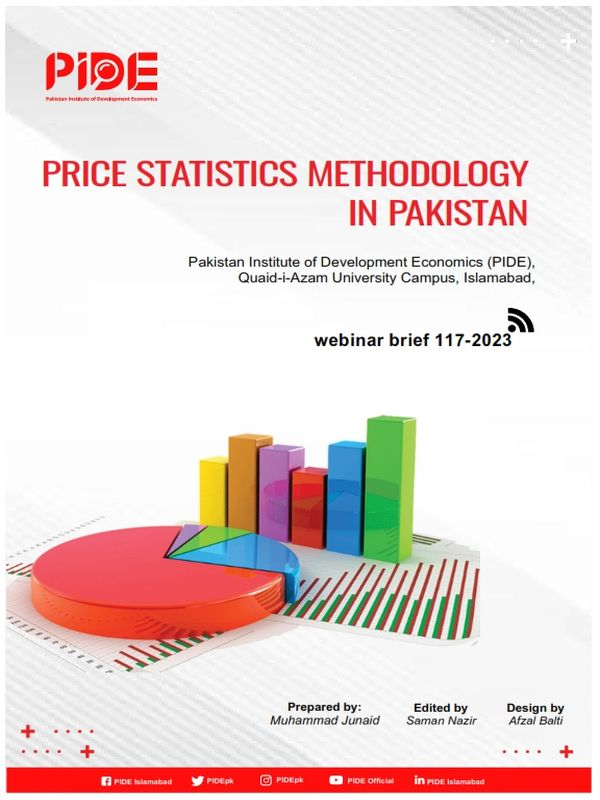
Pakistan Institute of Development Economics
- Home
Our Portals
MenuMenuMenuMenuMenuMenuMenu - ResearchMenuMenuMenuMenuMenuMenuMenu
- Discourse
- The PDR
- Our Researchers
- Academics
- Degree Verification
- Thesis Portal
- Our Portals
Price Statistics Methodology In Pakistan
Introduction and Background:
Since the current situation prevailing in the country is regarding inflationary pressure, which is 26% now and the highest in history, with due importance regarding the current situation, the Pakistan Institute of Development Economics, in collaboration with the Pakistan Bureau of Statistics, organized a session on price statistics of Pakistan. The session was held on the 31st of January, 2023. The session was headed by Dr. Bahrawar Jan, Deputy Director of General PBS.
The price statistics are the data regarding the prices of a basket of goods produced within the economy and consumed. It is computed by the price statistics section of PBS and is responsible for the collection of wholesale, retail, and producer prices. These prices are then calculated on a weekly basis as well as on a monthly basis. The weekly basis prices are computed as SPI, which is published every Friday. Meanwhile, there are other price indices like CPI, WPI, and SPI, which compute the prices on a monthly basis and are published on the first working day of every month. These data regarding prices are then shared with the help of print and electronic media, also through the mail, and uploaded on the website of PBS as well. PBS used international standards to compute its pricing statistics, that’s why they are similar to the pricing statistics of the IMF.
New price base 2015-16 and its features:
PBS rebased its pricing statistics after every ten years. The most recent one is for 2015-16. The pricing statistics for 2015-16 have many features which the older one neglected, and these are as follows; It includes the rural markets and gives the weights to rural regions according to their populations, and cities are treated according to their sizes to enhance their representation. Before this base of the pricing statistics, prices were computed on the basis of income quintiles, but in this pricing statistics, they computed prices on the basis of consumption quintiles. Ahead of this, General sales taxes, other taxes, and fuel pricing adjustments are also considered for the calculation of electricity tariff. Further, this base introduced the consumer weight approach in order to calculate the prices of gas and electricity. One of the main attributes of this pricing base is that it uses digital tablets to collect data that were manual earlier.
Major steps followed by PBS for the development of price indices:
First, they conduct the family budget survey like Household Integrated Economic Survey (HIES), Household Integrated Income and Consumption Survey (HIICS), etc. After that Fixation of a basket of goods and services happens, and then weights are derived for these baskets according to their importance. Ahead of this, the cities and markets are selected, and then the indices are computed. The technical committee approves all these steps after comprehensive research and comparison with international standards.
Regarding the Family Budget Survey, HIICS 2015-16 was conducted with a sample size of 26,688 households. This survey increased the coverage of CPI, which at the time after independence included only three major cities Lahore, Karachi, and Sialkot. Now according to the current price base SPI covers 17 cities with 50 markets, including 51 items; ahead of this, CPI covers 35 cities with 68 markets, including 356 items. CPI is computed both in urban and rural areas as well nationally. These cities are selected based on the population where stratified random sampling occurs to compute the pricing data, and SPI and CPI give weightage to both these cities. The markets are selected according to their size ranging between 1 to 11, with larger as well smaller size markets. The PBS staff at their regional offices collect all these pricing data from different sources like the agriculture market, grading departments, mandis, market committees, traders, businesses, journals, newspapers, etc. The scheduled timing of these CPI data collection is divided into different parts, which collect all the data till the 15th of every month.
Conclusion:
PBS is looking forward to the new base year will be rebased in 2024-25. Further, they will initiate the PPI from the producer’s perspective as well. The introduction of consumer markets weight, introduction of product quality weight, and coverage extensions of the regions will also be considered. Ahead of this, big data of online chains will be enhanced on which PBS has already taken initiatives like the usage of tablets to collect electronic data, and development of software like CAPI, and also the development of dashboards.



